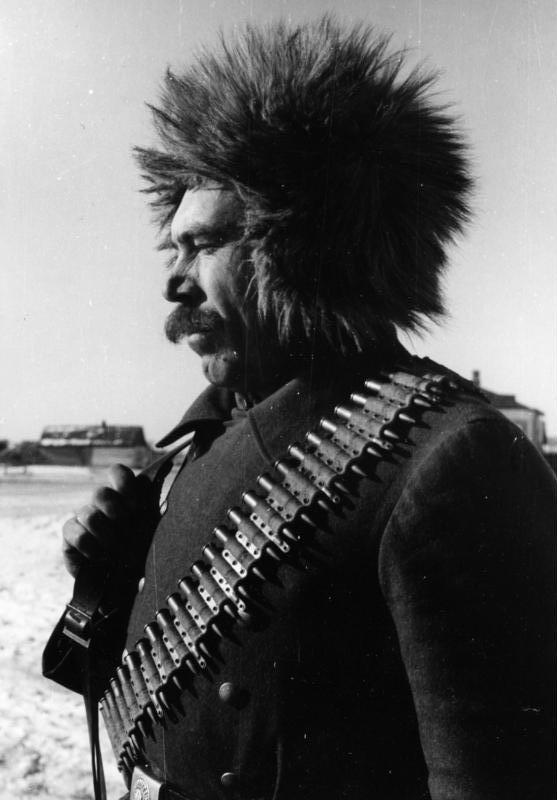Kalmücken-Kavallerie-Korps on:
[Wikipedia]
[Google]
[Amazon]
 The Kalmykian Cavalry Corps (german: Kalmücken-Kavallerie-Korps; also known as: german: Kalmücken Verband Dr. Doll, xal, Доктор Доллин Хальмг мөртә церг, translit=Doktor Dollin Xalmg mörtä tserg, , Dr. Doll Kalmyk Formation (Dr. Doll was an alias of )) was a unit of about 5,000 ethnic Kalmyk volunteers who chose to join the
The Kalmykian Cavalry Corps (german: Kalmücken-Kavallerie-Korps; also known as: german: Kalmücken Verband Dr. Doll, xal, Доктор Доллин Хальмг мөртә церг, translit=Doktor Dollin Xalmg mörtä tserg, , Dr. Doll Kalmyk Formation (Dr. Doll was an alias of )) was a unit of about 5,000 ethnic Kalmyk volunteers who chose to join the
 The Kalmykian Cavalry Corps (german: Kalmücken-Kavallerie-Korps; also known as: german: Kalmücken Verband Dr. Doll, xal, Доктор Доллин Хальмг мөртә церг, translit=Doktor Dollin Xalmg mörtä tserg, , Dr. Doll Kalmyk Formation (Dr. Doll was an alias of )) was a unit of about 5,000 ethnic Kalmyk volunteers who chose to join the
The Kalmykian Cavalry Corps (german: Kalmücken-Kavallerie-Korps; also known as: german: Kalmücken Verband Dr. Doll, xal, Доктор Доллин Хальмг мөртә церг, translit=Doktor Dollin Xalmg mörtä tserg, , Dr. Doll Kalmyk Formation (Dr. Doll was an alias of )) was a unit of about 5,000 ethnic Kalmyk volunteers who chose to join the German Army
The German Army (, "army") is the land component of the armed forces of Germany. The present-day German Army was founded in 1955 as part of the newly formed West German ''Bundeswehr'' together with the ''Marine'' (German Navy) and the ''Luftwaf ...
in 1942 rather than remain in Kalmykia
he official languages of the Republic of Kalmykia are the Kalmyk and Russian languages./ref>
, official_lang_list= Kalmyk
, official_lang_ref=Steppe Code (Constitution) of the Republic of Kalmykia, Article 17: he official languages of the ...
as German forces retreated before the Red Army. Stalin subsequently declared the Kalmyk population as a whole to be German collaborators in 1943 and ordered mass deportations to Siberia suffering great loss of life.
Origins
When Erich von Manstein led the 16th Motorized Infantry Division into Kalmykia in early 1942 he already had some Kalmyk advisors from a committee drawn together byGoebbels
Paul Joseph Goebbels (; 29 October 1897 – 1 May 1945) was a German Nazi politician who was the ''Gauleiter'' (district leader) of Berlin, chief propagandist for the Nazi Party, and then Reich Minister of Propaganda from 1933 to 19 ...
for propaganda purposes. These were supplemented by other Kalmyks who had settled in Belgrade
Belgrade ( , ;, ; Names of European cities in different languages: B, names in other languages) is the Capital city, capital and List of cities in Serbia, largest city in Serbia. It is located at the confluence of the Sava and Danube rivers a ...
following their flight with White Russian emigres after the Russian October Revolution.
Organization
The KKK acted within the German Wehrmacht as an independent allied force with all leadership positions taken byKalmyks
The Kalmyks ( Kalmyk: Хальмгуд, ''Xaľmgud'', Mongolian: Халимагууд, ''Halimaguud''; russian: Калмыки, translit=Kalmyki, archaically anglicised as ''Calmucks'') are a Mongolic ethnic group living mainly in Russia, w ...
. Most of the officers were Kalmyks themselves with previous Soviet military experience. A few Germans that were present within the corps performed only auxiliary and administrative functions.
Military actions
The Kalmykian Cavalry Corps fought with the Wehrmacht behind the lines, especially around theAzov Sea
The Sea of Azov ( Crimean Tatar: ''Azaq deñizi''; russian: Азовское море, Azovskoye more; uk, Азовське море, Azovs'ke more) is a sea in Eastern Europe connected to the Black Sea by the narrow (about ) Strait of Kerch, ...
. At the end of 1944, the surviving Kalmyk cavalry troops, together with their families, retreated with the German army. About 2,000 went to Silesia, Poland and 1,500 to Zagreb, Croatia, where they were reorganized to fight against the partisans.
End of the war
After the war, nearly all of the surviving Kalmyk soldiers along with the Kalmyk families that accompanied them were forcibly repatriated to the Soviet Union. Despite the fact that 23,750 Kalmyks served in the Red Army during World War II, the Kalmykian people were internally deported for 13 years as collective punishment for the actions of the Kalmykian Cavalry Corps.See also
*Tiger Legion
, image = Flag of the Indian Legion.svg
, image_size = 200px
, caption = Flag of the Indian Legion
, country =
, allegiance = Adolf ...
* Turkic, Caucasian, Cossack, and Crimean collaborationism with the Axis powers
References
{{Reflist Cavalry corps of Germany Foreign volunteer units of the Wehrmacht History of Kalmykia Kalmyk people 1942 establishments in Europe Collaboration with the Axis Powers Military units and formations established in 1942